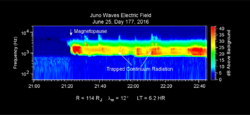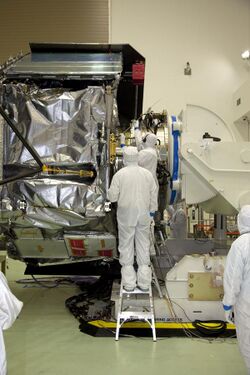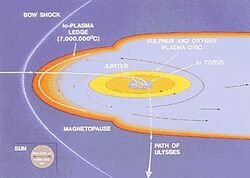Waves (Juno)
Topic: Engineering
 From HandWiki - Reading time: 6 min
From HandWiki - Reading time: 6 min

Waves is an experiment on the Juno spacecraft to study radio and plasma waves.[1][2] It is part of collection of various types of instruments and experiments on the spacecraft; Waves is oriented towards understanding fields and particles in Jupiter's magnetosphere.[2] Waves is on board the uncrewed Juno spacecraft, which was launched in 2011 and arrived at Jupiter in the summer of 2016.[1] The major focus of study for Waves is Jupiter's magnetosphere, which if could be seen from Earth would be about twice the size of a full moon.[3] It has a tear drop shape, and that tail extends away from the Sun by at least 5 AU (Earth-Sun distances).[3] The Waves instrument is designed to help understand the interaction between Jupiter's atmosphere, its magnetic field, its magnetosphere, and to understand Jupiter's auroras.[4] It is designed to detect radio frequencies from 50 Hz up to 40,000,000 Hz (40 MHz),[5] and magnetic fields from 50 Hz to 20,000 Hz (20 kHz).[6] It has two main sensors a dipole antenna and a magnetic search coil.[6] The dipole antenna has two whip antenna's that extend 2.8 meters (110 inches/ 9.1 feet) and they are attached to the main body of the spacecraft.[6][7] This sensor has been compared to a rabbit ears set-top TV antenna.[8] The search coil is overall a mu metal rod 15 cm (6 in) length with a fine copper wire wound 10,000 times around it.[6] There are also two frequency receivers that each cover certain bands.[6] Data handling is done by two radiation hardened systems on a chip.[6] The data handling units are located inside the Juno Radiation Vault.[9] Waves was allocated 410 Mbits of data per science orbit.[9]
On June 24, 2016, the Waves instrument recorded Juno passing across Jupiter's magnetic field's bow shock.[3] It took about two hours for the uncrewed spacecraft to cross this region of space.[3] On June 25, 2016, it encountered the magnetopause.[3] Juno would go on to enter Jupiter's orbit in July 2016.[3] The magnetosphere blocks the charged particles of the solar wind, with the number of solar wind particles Juno encountered dropping 100-fold when it entered the Jovian magnetosphere.[3] Before Juno entered it, it was encountering about 16 solar wind particles per cubic inch of space.[3]
There is various other antenna on Juno including the communication antennas and the antenna for the Microwave Radiometer.[9]
Two other instruments help understand the magnetosphere of Jupiter, Jovian Auroral Distributions Experiment (JIRAM) and Magnetometer (MAG) instrument.[10] The JEDI instrument measures higher energy ions and electrons and JADE lower energy ones, they are complementary.[10] Another object of study is plasma generated by volcanism on Io (moon) and Waves should help understand that phenomenon also.[6]
A primary objective of the Juno mission is to explore the polar magnetosphere of Jupiter. While Ulysses briefly attained latitudes of ~48 degrees, this was at relatively large distances from Jupiter (~8.6 RJ). Hence, the polar magnetosphere of Jupiter is largely uncharted territory and, in particular, the auroral acceleration region has never been visited. ...—A Wave Investigation for the Juno Mission to Jupiter[11]
Another issue that came up in 2002, was when Chandra determined with its high angular resolution that X-rays were coming from Jupiter's poles.[12] Einstein Observatory and Germany's ROSAT previously observed X-rays from Jupiter.[12] The new results by Chandra, which took the observations during December 2000, showed X-rays coming from the magnetic north pole not the aurora.[12] Roughly every 45 minutes Jupiter sends out a multi-gigawatt X-ray pulse, and this is synchronized with an emission in radio at 1 to 200 kHz.[12] Galileo orbiter and Ulysses solar orbiter picked up the radio emissions every 45 minutes.[12] The radio emissions were discovered before the X-rays, they have been detected since the 1950s, and there is even Citizen astronomer project orchestrated by NASA called Radio Jove for anyone to listen to Jupiter's radio signals.[13][14] Kilometric radio radiation was not detected until the Voyager flybys of Jupiter in the late 1970s.[14] Two candidates for the source of the X-rays are particles of Solar wind or from Io.[12]
Waves was developed at the University of Iowa, and the experiment is led by a research scientist there.[8]
Sensors
There are two main sensors for Waves, and these field signals to the frequency receivers.[6] Both sensors are attached to main spacecraft body.[6]
- Dipole antenna
- Magnetic search coil
The MSC is made of a rod of Mu-metal (a ferromagnetic alloy of nickel and iron) wrapped in fine copper wire.[6]
Frequency receiver
There are two frequency receivers that each cover certain bands, a high band and a low band, which in turn has different receiving sections.[6] The receivers are housed in the Juno Radiation Vault along with other electronics.[9]
Breakdown:[6]
- High Frequency Receiver[6]
- High Frequency Receiver ~100 kHz - 40 MHz (Spectrum (High) and Waveform (Low))[6]
- High Frequency Waveform Receiver[6]
- Baseband receiver includes:[6]
- variable-gain amplifier[6]
- 100 Hz to 3 MHz band-pass filter[6]
- 12-bit analog-to-digital converter[6]
- Double sideband heterodyne receiver for 3 to 40 MHz (swept frequency receiver)[6]
- Baseband receiver includes:[6]
- Low Frequency Receiver[6]
All outputs are sent to the Data Processing Unit (DPU)[6]
Data Processing Unit (DPU)
The output from the frequency receivers is in turn processed by the Juno DPU.[6] The DPU has two microprocessors that use field programmable gate arrays are they are both system on chip designs.[6] The two chips:[6]
- Y180 intellectual property core
- Floating point arithmetic unit
The DPU sends data to the main Juno computer for communication with Earth.[6] The electronics are in the Juno Radiation Vault along with the receivers.[9]
Multimedia
Waves has detected radio emissions from the Jupiter auroras, the most powerful known in the Solar System to date.[15] File:Juno Captures the 'Roar' of Jupiter.webm
See also
- Other instruments on Juno
- Radio
- Plasma
- Waves in plasmas
- Ulysses (spacecraft)
- Magnetosphere of Jupiter
- Radio astronomy
- FIELDS (investigation on the Parker Solar Probe, launched summer of 2018)
- Plasma Wave Subsystem (Instrument on the Voyager probes)
References
- ↑ 1.0 1.1 Greicius, Tony (2015-03-13). "Juno Spacecraft and Instruments". NASA. https://www.nasa.gov/mission_pages/juno/spacecraft/index.html.
- ↑ 2.0 2.1 Brown, Geoff (2016-06-30). "NASA's Juno and JEDI prepare to unlock the mysteries of Jupiter". http://hub.jhu.edu/2016/06/30/juno-spacecraft-jupiter-mission/.
- ↑ 3.0 3.1 3.2 3.3 3.4 3.5 3.6 3.7 Greicius, Tony (2016-06-29). "NASA's Juno Spacecraft Enters Jupiter's Magnetic Field". NASA. https://www.nasa.gov/feature/jpl/nasas-juno-spacecraft-enters-jupiters-magnetic-field.
- ↑ "Juno's Instruments | Mission Juno". https://www.missionjuno.swri.edu/media-gallery/instruments.
- ↑ Sampl, M.; Oswald, T.; Rucker, H. O.; Karlsson, R.; Plettemeier, D.; Kurth, W. S. (November 2011). "First results of the JUNO/Waves antenna investigations". 2011 Loughborough Antennas & Propagation Conference. pp. 1–4. doi:10.1109/LAPC.2011.6114038. ISBN 978-1-4577-1016-2.
- ↑ 6.00 6.01 6.02 6.03 6.04 6.05 6.06 6.07 6.08 6.09 6.10 6.11 6.12 6.13 6.14 6.15 6.16 6.17 6.18 6.19 6.20 6.21 6.22 6.23 6.24 6.25 6.26 6.27 "The Juno Waves investigation". http://meetingorganizer.copernicus.org/EPSC2012/EPSC2012-281.pdf.
- ↑ "Jupiter rendezvous". 2016-06-29. https://now.uiowa.edu/2016/06/jupiter-rendezvous.
- ↑ 8.0 8.1 "Juno, and its University of Iowa-built instrument, about to reach Jupiter | The Gazette". The Gazette. http://www.thegazette.com/subject/news/education/higher-education/juno-and-its-university-of-iowa-built-instrument-about-to-reach-jupiter-20160627.
- ↑ 9.0 9.1 9.2 9.3 9.4 "Key and Driving Requirements for the Juno Payload Suite of Instruments". http://personal.linkline.com/dodger/AIAA-2007-6111.pdf.
- ↑ 10.0 10.1 "Press Release - NASA's Juno and JEDI: Ready to Unlock Mysteries of Jupiter". Johns Hopkins Applied Physics Laboratory. June 29, 2016. http://www.jhuapl.edu/newscenter/pressreleases/2016/160629.asp.
- ↑ Kurth, et al - A Wave Investigation for the Juno Mission to Jupiter - 2008
- ↑ 12.0 12.1 12.2 12.3 12.4 12.5 "Puzzling X-rays from Jupiter | Science Mission Directorate" (in en). https://science.nasa.gov/science-news/science-at-nasa/2002/07mar_jupiterpuzzle.
- ↑ Sky and Telescope - The Radio Jove Project: Listening in on Jupiter - 2013
- ↑ 14.0 14.1 John W. McAnally (2007). Jupiter: and How to Observe It. Springer Science & Business Media. p. 82. ISBN 978-1-84628-727-5. https://books.google.com/books?id=4jMXSemKgqQC&pg=PA82.
- ↑ "Juno Sends Back Incredible New Images of Jupiter | Planetary Science, Space Exploration | Sci-News.com" (in en-US). Breaking Science News | Sci-News.com. http://www.sci-news.com/space/juno-new-images-jupiter-04160.html.
External links
 |
32 views | Status: cached on July 15 2024 00:58:07
↧ Download this article as ZWI file
 KSF
KSF








